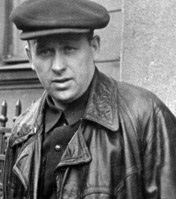Name Yakov Taubin | ||
 | ||
Died October 28, 1941, Samara Oblast, Russia | ||
Yakov Grigoryevich Taubin (Russian: Yakov Grigor'evich Taubin (1900–1941)) was a Belorussian Soviet weapons designer. He is best known for creating the first successful automatic grenade launcher. He also designed a prototype gun for the Ilyushin Il-2 Stormovik, but rather than accepting his design, Soviet authorities executed him.
Contents
Early life
Taubin was born in 1900 in Pinsk in what was then the Russian Empire (now in Belarus). The date of his birth is not known. His father, an accountant, died in 1915.
In 1929 Taubin entered the Odessa National Academy of Food Technologies (then called the Odessa Institute of Grain and Flour Technology) in the Faculty of Design. While there, during student military training at the academy in the summer of 1931, he encountered a grenade launcher, the single-shot Dyakonov. He set himself the task of creating an automated version.
The Taubina AG-2 grenade launcher
In the fall of 1931 he sent a draft of a design, which used regular 40.8 mm (1.61 in) MG Dyakonov rifle grenades, to the Red Army artillery leadership, and it was accepted for development at the Kovrovsky Tool Plant Number Two. Taubin left the Odessa Institute of Grain and Flour Technology to head the development effort. Later, a group of experts led by Taubin continued this work in Moscow, being organized in the spring of 1934 as an independent design office under OKB-16 of the People's Commissariat of Arms of the USSR. Here, in the period from 1934 to 1938, under Taubin's direction, the world's first infantry automatic grenade launcher was developed and perfected.
This weapon, the AG-2 Taubina, used a 40.6 mm (1.60 in) round with a fragmentation grenade based on the standard Dyakonov, fitted with a flangeless sleeve. The Taubina was magazine-fed and could fire single shots or bursts either in either direct or indirect fire. The rate of fire of earlier models, already substantial at 50 to 60 rounds per minute, was later increased to about 436 rounds per minute, although the magazine was initially just five rounds.
The prototypes used a small powder charge which did not provide reliable operation, so the weapon had to be substantially redesigned. Initially gas-operated, in 1936 it was to changed to recoil operation. The Taubina originally had a tripod mount, and was later mounted on a light wheeled machine-gun carriage. Barrel heating and wear was small due to the small charge, so the maximum rate of fire could be maintained, but the charge was large enough to achieve a maximum range for the weapon of 1,200 m (3,900 ft).
The Taubina had some shortcomings. The extractor and ejector springs were of poor quality, leading to 7.2% of shots causing a failure. The machine was also inaccurate, with rounds scattering in azimuth. After each clip it was necessary to re-lay the weapon.
The idea of an automatic grenade launcher was opposed by Grigory Kulik, chief of the Main Artillery Directorate, and other military leaders. In 1937–1938, the Taubina was rejected as a company-level support weapon in favor of a mobile, cheap, and well-tested 50 mm (2.0 in) mortar, based on a 1938 design by B. I. Shavyrina.
In 1938, sea trials of the Taubina were made on craft of the Dnieper Flotilla; based on these, the Navy made a small order in January 1939 but soon reversed itself. The Taubina was used successfully in small numbers by the Red Army during the Winter War against Finland, but soon all work on the automatic grenade launcher was ended.
Artillery expert Alexander B. Shirokorad, author of the Encyclopedia of Soviet Artillery and other works, has decried the failure to develop the Taubina, blaming a shortsighted "mortar mafia".
Other weapons
Taubin, together with leading OKB-16 designer Mikhail Baburin, developed other weapons.
For the Ilyushin Il-2 Stormovik, Taubin developed the 23mm MP-6 gun (two were to be mounted on each aircraft). The MP-6 used a short recoil system. It weighed 70 kilograms (150 lb), had an initial muzzle velocity of 900 metres per second (3,000 ft/s), and a rate of fire of about 600 rounds per minute, with an 81-round clip provided. Initial airborne trials were conducted (not on the Il-2) in the spring of 1940 and factory trials on the Il-2 in August 1940. In flight, the ammunition clips sometimes became dislodged because of their large surface, which caused them to experience significant aerodynamic pressure, so the gun was converted to being belt-fed. Although this gun was ultimately not used on on the Il-2, Taubin (along with Barburin) was awarded the Order of Lenin for designing it.
Competitive trials were conducted between Taubin's design and the newly developed, gas-operated Volkov-Yartsev VYa-23, also a 23mm gun with generally similar characteristics. The VYa-23 won the trials and development of the MP-6 gun was terminated in May 1941 (and Taubin was arrested).
Taubin also developed a 23mm tank gun (the PT-23TB (Tank Gun 23mm System Taubina-Baburina)), a 23mm infantry air defense gun, and a 12.7mm aircraft machine gun (the AN-12.7), but none of these were brought to full development.
Arrest and execution
On the night of May 15–16, 1941, Taubin and several associates were arrested on charges of preserving samples of unfinished weapons and egregiously plotting production of technically unfinished and unsatisfactory weapons systems, namely the 23mm infantry anti-aircraft gun and the 12.7mm machine gun.
Following trial, Taubin was executed by shooting on October 17, 1941, in the village of Barbysh near Samara, Russia (then called Kuybyshev). This place is now Yuri Gagarin Park within the city limits of Samara and contains the mass graves of several thousand victims of execution by Soviet authorities.
The actual impetus for Taubin's arrest and execution was probably Kulik's strong opposition to the AG-2 automatic grenade launcher, and consequent hostility toward Taubin.
Taubin was rehabilitated on December 20, 1955.
